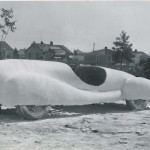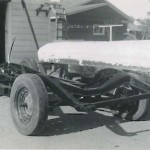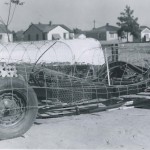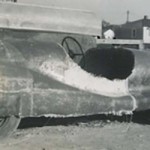

Here You See 20 Year Old Burch Roark Working on Fixing the Chicken Wire to the Heavy Gauge Wire that Would Serve as the Shape of His Body.
Hi gang…
How many specials were made in the 1950’s?
In my recent trip to Kettering University and the John Bond (Road and Track) archive, I learned from letters in the archive that John Bond thought that perhaps as many as 1000 were made during that time, and I wish each one had been documented in every detail. Of course if it had, there would be little for Rick D’Louhy and I to do concerning research, and our “Indiana Jones” approach to locating the history of these cars would never have been (and we’d have a lot more free time too!)
But the days of finding undocumented stories or cars are far from over, and that’s exactly what happened when Stan Crawford (Glasspar and Atlas/Allied owner) introduced me to his long-term friend, Burch Roark of Spokane, Washington.
The Donor Car Arrives
Burch was born in 1933, and was just 17 years old in late 1950 when he started building his hot rod project at his parent’s home in Lewiston, Idaho. He didn’t know at that time he was going to build a fiberglass body, but he knew he was going to build a hot rod of some type.
While in high school in Lewiston, a friend of Burch’s, Noel Berkeley, had acquired a 1936 Ford 5 window coupe. Noel had cut the top off and was going to make a convertible out of the car – an open roadster which was popular in the late 1940’s and 1950’s too. Money was tight, and Noel knew he needed a new battery, but couldn’t afford it. So instead, he push started it to get it going each time. Unfortunately, the last time he tried this, the hand throttle was pulled out, and when the car started it roared off down the street without a driver. Luckily, no one was hurt and a block or so later the car hit a tree. The front end was damaged, but everything else including the frame was fine.

The 1936 Ford 5 Window Coupe Donor Frame. Here the Frame has Already Been Z’d to Lower it to the Proper Height.
In the late 1940’s, a late 1930’s car even in good shape cost $50 to $75. When Burch went to help his friend tow it home, Noel was so frustrated that he told Burch “I’d sell this car for 2 cents.” Burch asked him how much he really wanted, and they settled for what was in his pocket – $2.50. Noel signed over the title and handed it over to Burch. Not a bad price for a great donor car of the era.
Preparing the Chassis
Burch quickly started, took off the body and began to prepare the chassis and drivetrain. He removed the body and did what many people in Lewiston were doing back then. They had terrible flooding problems, and the Clearwater and Snake rivers came together at Lewiston. People routinely pushed cars and large objects over the bank to shore up the sides of the river, and the city pushed dirt over it to give the bank added strength. So if anyone goes out there today and finds the remnants of a 1936 Ford coupe body on the Snake or Clearwater Rivers, you’ll have Burch Roark to thank for his contribution to the maintenance of the river bank.
Next, he rebuilt the engine, went thru the transmission and rear end to get everything in shape, and then Z’d the frame right ahead of the back axle to lower the car. He did this keeping the wheelbase of the car intact (1936 Ford had a 112” wheelbase. This would have made it longer than most fiberglass sports cars at the time by about 12 inches.) Finally, Burch strapped a box to the frame rails, and began test driving the chassis and drivetrain to make sure it was running good. Burch told me, “I ran it up and down the alley. It sure ran sweet at this stage, but a bit funny to drive without a body.”
Designing the Car
Like many young men of the era, Burch dreamed of driving a car of his own design. He made sketch after sketch and finally settled on some common design elements of cars from the late 1940’s / early 1950’s. Burch wanted his car to sit as low as possible, and he recalls that the bottom of the windshield was very low – perhaps 40” or so. But let’s hear Burch’s talk about his design in his own words. Click on the small black triangle below to hear Burch’s recollections. It’s about a minute long.
Shortened Burch
In 1951, fiberglass cars were only a thought for the future. Things would change quickly, though, and when fiberglass started to become talked more about, his plans solidified, and off he went. I asked Burch “why fiberglass?” He shared with me the following:
“I had seen guys with small boats made out of fiberglass, and read articles in Popular Mechanics and Mechanix Illustrated. Everywhere you read, you learned what a unique thing fiberglass was and what could be done with it, and all the attention caught my eye. At the time, there was a boat builder near me who built boats with wood frames covered in tin called “Can’t Sink ‘Em’s. He sold fiberglass materials, and this is where I bought materials to make my car. Fiberglass was so new, very few people locally could help with hands on experience, so I read up on what I could find and started making my car.”
Remember gang….1951 and 1952 were still the early days of fiberglass. Bill Tritt from Glasspar and Eric Irwin of Lancer had yet to show their cars in the November 1951 Petersen Motorama. Burch was on the path to making one of the first fiberglass cars in the Northwest United States.
Building the Mold

Another Shot at the Start of the Process of Shaping the Design of the Car – The Chicken Wire Had Just Been Started Here.
Burch had never considered buying a body already built like a Victress or a Glasspar, and it makes sense if you think of the time period where he was doing his work. It was only by mid to late 1952 when Glasspar, Lancer, and Skorpion bodies became more widely known, but by then Burch had formalized his plan and his work had begun. Plus, as Burch tells me, he wouldn’t have had the extra money to buy and ship a car body too. He had just started college at that time..
In 1952, Burch’s family moved to Spokane Washington – just north and a bit west of Lewiston Idaho, and this is where he began working on the fiberglass body. Burch remembers that he started working on the plaster mold in 1952. He had graduated from high school in the summer of 1951 and started college in the Fall of the same year. In 1952, his family moved to Spokane, Washington, and it would be there in the summer of 1952 where Burch would begin to build the body for his car.
In the early 1950’s, many fiberglass bodies were created using a male mold. What this means is that the car body was sculpted in plaster (sometimes in clay) and the fiberglass was applied directly to the mold to take the shape designed. If all went well, the fiberglass body would “release” from the male mold, and voila….you’d have your first body.
Early on, many bodies became permanently attached to the plaster mold causing nightmares for the builders and sometimes destruction of the very mold made. When things went well and the body separated from the mold, all that was left to do was tens if not hundreds of hours of sanding to get the surface smooth, and the cutting / placement of any doors, hood, or trunk. It was the “male mold” process that Burch decided to use.

This is Actually the Mold for the Body. The Plaster Has Been Fully Formed Over the Chicken Wire and the Sanding has Started to Prep the Mold for Fiberglass.
To approximate the shape of his design, Burch formed the basic design with thick gauge wire and tied together the pieces where the wires crossed. Next, he formed chicken wire over the basic design so he could apply plaster and approximate the rough shape of the design of his car.
Pulling the Body From the Mold
Burch used house plaster over the chicken wire and shaped it close to what he wanted. When the mold/shape was finally ready, he laid fiberglass directly over the plaster “buck”, and when he had several layers of fiberglass on it, he stopped working and let the body cure. Burch says that he was told at the time that it needed to be in the sunlight and / or have exposure to UV lights in order to fully harden.
In checking with some of the fiberglass guys from back in the day (Victress Organization), they shared with me that it should have been able to cure without sunlight – but the warmth in the direct sun certainly would have sped up the catalyst process and expedite hardening of the resin in the fiberglass. Burch later told me that without sunlight, the fiberglass he laid would still be uncured after 2 weeks in a dark and cold garage. So maybe the UV/sunlight was a critical component to the fiberglass materials purchased up in Spokane at the time. When finished, Burch estimates the body weighed 100 pounds.
Burch was going to college at this time and he worked on the car mostly when he returned home each year in the summer. He remembers working on the body in 1952, 1953, and 1954, and estimates he spent over 1000 hours on the car to get it to the point it was when he later sold it. (Burch later told me that he thought the car was about half way completed, and that it would have taken another 1000 hours, more or less, to finish the car.)
Fitting the Body to the Chassis
When the body had cured, he took the body off the mold, and destroyed the mold to get at the car. That is, the mold was built right on the chassis, and it was necessary to remove it in order to fit the body properly to the chassis. Gone forever was the plaster, chicken wire, and heavy wire gauge that supported the mold. He then used electrical conduit and welded it to the frame of the car to support the new fiberglass body.
Dashboard
Burch remembers building a custom dashboard for his car. We couldn’t find pictures of it, but he remembered it vividly as follows:

Here You Can See the “Panels” of Fiberglass Cloth That Had Been Applied Directly to the Mold / Plug of the Body.
“My grandmother had given me some doe skin and I decided to use it. I covered the dash in a pleated fashion and made it ready for the instruments. Along the river where I had dumped the original coupe body, I found a 1937 Lincoln Zephyr which was pretty much destroyed, but the instruments were intact. I took those instruments out and put it in my dashboard.”
Almost Finishing the Car
This was as far as Burch completed the car.
He had designed it so that you could step in without doors, but he still needed to cut a hood, maybe a trunk, and find a windshield for it. Headlights, taillights, upholstery, seats, and paint were needed too. And wheel openings were needed as well.
Burch had been planning to build a scoop or air intake under the front edge of the body. As he recollects, the grill would not have been a focal point of the car – he was going to use whatever he could find, and it would not have been a major design element. He planned for the headlights to be in the fenders and down low. I thought “retractable” like a 1937 Cord, but Burch said “no” – standard headlights were going to be used.
College Ends and The Car Moves On

And Here’s the Final Shot of the Finished Fiberglass Body Now Attached to the Chassis and Ready for Burch to Begin Test Driving – Ford Flathead V8 and All.
Burch had finished college in the Spring of 1955. After graduation, he decided to go into the Air Force, so he sold the car to a friend of his in mid to late 1955 and left for the Air Force in October. He never saw his car again. He did look for it a few years later and went back to the place where the guy worked who bought it. He couldn’t find the guy, but did talk to the owner of the business where the guy had worked. The owner told him that the new owner pushed the car too fast and didn’t break in the newly rebuilt engine. Consequently, on one of the first test drives of the car, the engine blew up. What a shame.
And for those of you curious about what Burch did after joining the Air Force, he went on to become a pilot. He flew mostly propeller planes such as the T34 trainer (single engine), T28 trainer (single engine), B25 WWII Bomber (twin engine/twin tail), twin engine C47 (DC3’s to us “civilians”), T29 twin engine
Thanks to Burch Roark for taking the time to share his story and memories with us and the wonderful pictures as well.
Until next time gang….
Glass on….
Geoff
——————————————————————–
Click on the Images Below to View Larger Pictures
——————————————————————-
- The 1936 Ford 5 Window Coupe Donor Frame. Here the Frame has Already Been Z’d to Lower it t the Proper Height.
- Here You See 20 Year Old Burch Roark Working on Fixing the Chicken Wire to the Heavy Gauge Wire that Would Serve as the Shape of His Body.
- Here’s the Wire Frame As Seen From the Back of the Car
- Another Shot at the Start of the Process of Shaping the Design of the Car – The Chicken Wire Had Just Been Started Here.
- This is Actually the Mold for the Body. The Plaster Has Been Fully Formed Over the Chicken Wire and the Sanding has Started to Prep the Mold for Fiberglass.
- Here You Can See the “Panels” of Fiberglass Cloth That Had Been Applied Directly to the Mold / Plug of the Body.
- And Here’s the Final Shot of the Finished Fiberglass Body Now Attached to the Chassis and Ready for Burch to Begin Test Driving – Ford Flathead V8 and All.





This is my uncle. He is one of the most remarkable men I have ever known. Currently 82 years old and still working on cars and motors in his shop.
An amusing tale of the perils of designing and trying to build a car of your own design..I had a few of the same problems even tho I thoughtI I knew all about fiberglass construction,(I didn’t)..
Mel